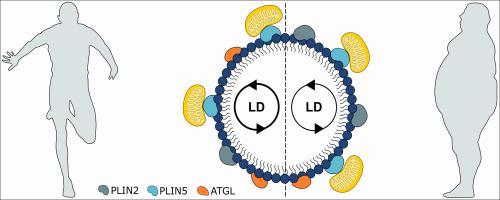Biochimica et Biophysica Acta (BBA) - Molecular and Cell Biology of Lipids ( IF 4.8 ) Pub Date : 2020-11-04 , DOI: 10.1016/j.bbalip.2020.158852 Anne Gemmink , Sabine Daemen , Bram Brouwers , Joris Hoeks , Gert Schaart , Kèvin Knoops , Patrick Schrauwen , Matthijs K.C. Hesselink

|
In many different cell types neutral lipids can be stored in lipid droplets (LDs). Nowadays, LDs are viewed as dynamic organelles, which store and release fatty acids depending on energy demand (LD dynamics). Proteins like perilipin 2 (PLIN2) and PLIN5 decorate the LD membrane and are determinants of LD lipolysis and fat oxidation, thus affecting LD dynamics. Trained athletes and type 2 diabetes (T2D) patients both have high levels of intramyocellular lipid (IMCL). While IMCL content scales negatively with insulin resistance, athletes are highly insulin sensitive in contrast to T2D patients, the so-called athlete's paradox. Differences in LD dynamics may be an underlying factor explaining the athlete's paradox. We aimed to quantify PLIN2 and PLIN5 content at individual LDs as a reflection of the ability to switch between fatty acid release and storage depending on energy demand. Thus, we developed a novel fluorescent super-resolution microscopy approach and found that PLIN2 protein abundance at the LD surface was higher in T2D patients than in athletes. Localization of adipocyte triglyceride lipase (ATGL) to the LD surface was lower in LDs abundantly decorated with PLIN2. While PLIN5 abundance at the LD surface was similar in athletes and T2D patients, we have observed previously that the number of PLIN5 decorated LDs was higher in athletes, indicating more LDs in close association with mitochondria. Thus, in athletes interaction of LDs with mitochondria was more pronounced and LDs have the protein machinery to be more dynamic, while in T2D patients the LD pool is more inert. This observation contributes to our understanding of the athlete's paradox.
中文翻译:

用脂蛋白作为体内脂质液滴动力学的标志物修饰肌细胞脂质液滴:针对训练有素的运动员和胰岛素抵抗性个体的超高分辨率显微镜研究
在许多不同的细胞类型中,中性脂质可以存储在脂质滴(LDs)中。如今,LD被视为动态细胞器,根据能量需求(LD动态)来存储和释放脂肪酸。像perilipin 2(PLIN2)和PLIN5这样的蛋白修饰了LD膜,并且是LD脂解和脂肪氧化的决定因素,因此影响了LD动力学。受过训练的运动员和2型糖尿病(T2D)患者均具有高水平的肌内脂质(IMCL)。尽管IMCL含量随胰岛素抵抗呈负相关,但与T2D患者(所谓的运动员悖论)相比,运动员对胰岛素高度敏感。LD动力学的差异可能是解释运动员悖论的潜在因素。我们旨在量化各个LD处的PLIN2和PLIN5含量,以反映根据能量需求在脂肪酸释放和储存之间进行切换的能力。因此,我们开发了一种新颖的荧光超分辨率显微镜方法,发现在T2D患者中LD表面的PLIN2蛋白丰度高于运动员。在大量装饰有PLIN2的LD中,脂肪细胞甘油三酸酯脂肪酶(ATGL)在LD表面的定位较低。虽然运动员和T2D患者在LD表面的PLIN5丰度相似,但我们之前观察到运动员中PLIN5装饰的LD的数量较高,这表明与线粒体密切相关的LD较多。因此,在运动员中,LDs与线粒体的相互作用更为明显,并且LDs具有更动态的蛋白质机制,而在T2D患者中,LD库更为惰性。这种观察有助于我们理解运动员的悖论。



























 京公网安备 11010802027423号
京公网安备 11010802027423号